Antioxidant hydrazides and derivatives thereof having multifunctional activity
a technology of antioxidant hydrazide and derivatives, which is applied in the direction of liquid carbonaceous fuels, lubricant compositions, fuels, etc., can solve the problems of reducing the ability of crankcase engine oil to effectively lubricate the engine, affecting and reducing the ability of the crankcase engine to lubricate the engine. to prevent the effect of antioxidant bloom
- Summary
- Abstract
- Description
- Claims
- Application Information
AI Technical Summary
Benefits of technology
Problems solved by technology
Method used
Image
Examples
example 1
[0090]
[0091] In the first step, to a 500 mL round bottom flask equipped with mechanical stirring, temperature control, nitrogen blanket, reflux condenser, addition funnel, and 0.67 mole of N-phenyl phenylenediamine was added to 9.6 weight percent of acid-leached bentonite clay (Filtrol 20×). The reaction mass was heated to 130° C. and the addition funnel was charged with 0.7 mole of butyl acrylate. At this temperature the butyl acrylate was added drop-wise over two hours and the temperature was maintained for an additional 3 hours. The temperature was then raised to 135° C. and an additional 0.23 mole of butyl acrylate was added through the addition funnel over about 30 minutes. The temperature was then maintained for an additional 2 hours. The reaction mass was cooled to 75° C. and filtered through a preheated bed of Celite. The filtered liquid was taken up in 500 mL of cyclohexane and allowed to precipitate. The precipitated material was then re-crystallized from 98:2 cyclohexane:...
example 2
[0093]
[0094] In the first step, to a 250 mL round bottom flask equipped with mechanical stirring, temperature control, nitrogen blanket, and reflux condenser, 0.41 mole of N-isopropyl-N-phenyl phenylenediamine (Flexzone 3C, Crompton Corporation) was added to 1.09 moles of butyl acrylate. The reaction mass was heated to 35° C. and 10.6 weight percent of acid-leached bentonite clay (Filtrol 20×) was charged. The temperature was then raised to 142° C. and maintained there for 66 hours. The reaction mass was cooled to 75° C. and filtered through a preheated bed of Celite. The filtered liquid was vacuum distilled at 60° C. to a pressure of 4 mm Hg to remove unreacted butyl acetate. One hundred and sixteen grams of solid was obtained.
[0095] In the second step, a 250 mL round bottom flask equipped with mechanical stirring, temperature control, nitrogen blanket, and reflux condenser was charged with 150 grams of the material made by the first step and 75 mL of isopropanol. Hydrazine monohy...
example 3
[0096]
[0097] In the first step, an autoclave was charged with 1 mole of N-phenyl phenylenediamine, 1.21 moles of methyl acetoacetate, 157 grams of isopropanol, and 6.2 grams dry equivalent of platinum sulfide on carbon. The autoclave was purged with nitrogen followed by hydrogen, then pressurized to 700 PSI with nitrogen and heated to a maximum of 85° C. in 30 minutes and held there for two hours. The reaction mass was then cooled, removed with additional isopropanol, and filtered.
[0098] In the second step, a 5 liter round bottom flask equipped with mechanical stirring, temperature control, nitrogen blanket, and reflux condenser was charged with 501 grams of the material made in the first step (˜50% in isopropaniol). At room temperature 1.02 moles of hydrazine monohydrate was added to the reaction mass, whereupon an exotherm of ˜15° C. over 10 minutes was observed. The reaction mass was then heated to 70° C. and held there for 3 hours, followed by heating to 80° C. and holding for ...
PUM
| Property | Measurement | Unit |
|---|---|---|
| Composition | aaaaa | aaaaa |
| Structure | aaaaa | aaaaa |
Abstract
Description
Claims
Application Information
 Login to View More
Login to View More - R&D
- Intellectual Property
- Life Sciences
- Materials
- Tech Scout
- Unparalleled Data Quality
- Higher Quality Content
- 60% Fewer Hallucinations
Browse by: Latest US Patents, China's latest patents, Technical Efficacy Thesaurus, Application Domain, Technology Topic, Popular Technical Reports.
© 2025 PatSnap. All rights reserved.Legal|Privacy policy|Modern Slavery Act Transparency Statement|Sitemap|About US| Contact US: help@patsnap.com



